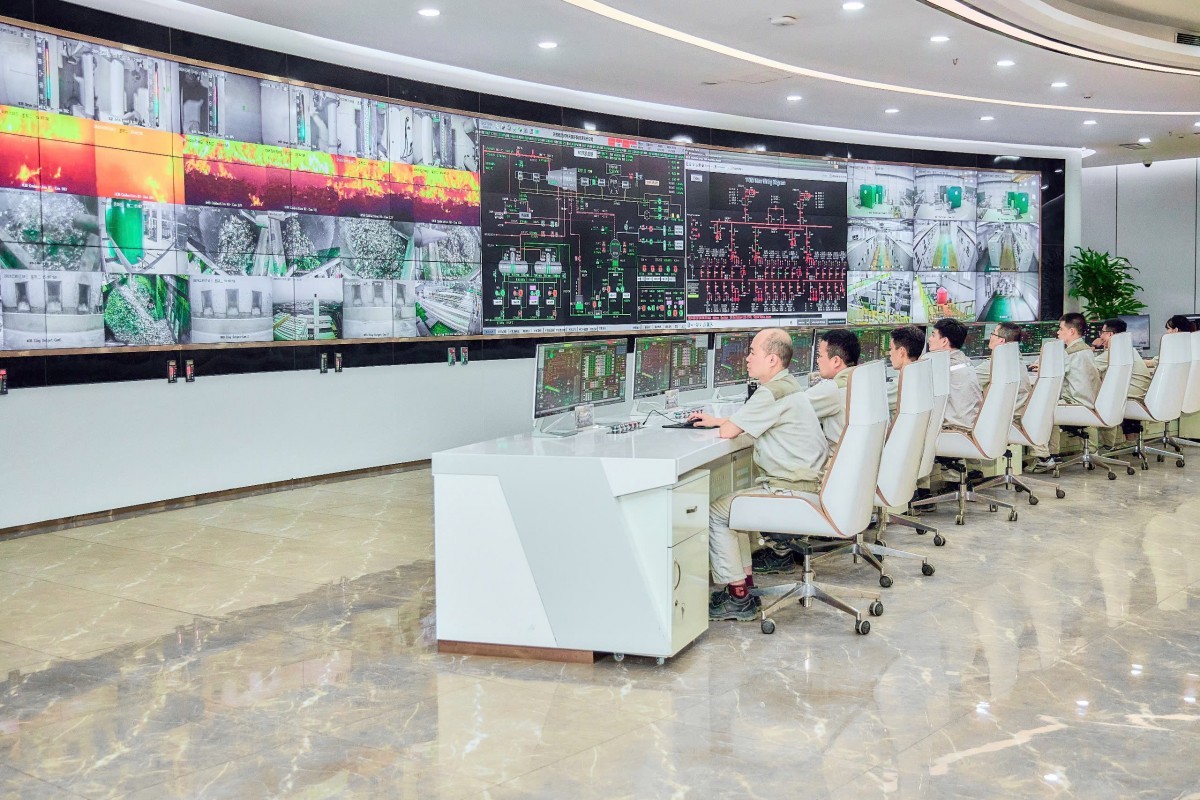Providing Clean Electricity: Hanoi’s Innovative Approach
Located in the Nam Son Waste Treatment Complex, Soc Son District, the Hanoi Thien Y Environmental Energy Joint Stock Company’s plant is a powerhouse of sustainable innovation. With a robust infrastructure comprising five incinerators, this facility is designed to handle approximately 5,000 tonnes of waste daily, generating a substantial 90 MW of power.
Since its inauguration in 2019, the plant has been a pivotal contributor to Hanoi’s environmental sustainability agenda. It has successfully mitigated pollution, converted waste into a valuable resource, and supported the city’s socioeconomic development.

The Soc Son Waste-to-Energy Plant’s Central Control Room: A Hub of Sustainable Operations
The plant’s operations have been marked by stability and efficiency in its first and second phases, with a daily burning capacity of 4,000 tonnes and a reception capacity of 5,000 tonnes. Its two power generation units produce approximately 60 MW of electricity, adhering to the stringent environmental standards set by Vietnam and the EU 2010.
Currently, the third phase of trial operations has been successfully completed, and the plant is poised to reach its full potential with a total power generation capacity of 90 MW.
Do Tien Dung, Deputy General Director of Hanoi Thien Y Environmental Energy Joint Stock Company, assures that the waste treatment process is meticulously managed. It involves waste reception, storage in pits for mixing and drying, incineration, and energy recovery, with the generated electricity being fed back into the national grid to fuel socioeconomic progress.
The Soc Son Waste-to-Energy Plant has been instrumental in Hanoi’s journey towards reducing landfill waste, aligning seamlessly with the city’s vision of a green, clean, modern, and civilized future.
Processing a Significant Proportion of Hanoi’s Waste
According to the Hanoi Department of Natural Resources and Environment, the city grapples with 6,500-7,000 tonnes of waste generated daily, primarily relying on landfills for disposal. However, with major sites like Nam Son and Xuan Son nearing capacity, environmental risks loom large.
The Soc Son Waste-to-Energy Plant has risen to the challenge, effectively processing a remarkable 70% of Hanoi’s daily waste, bringing about a gradual yet significant improvement in the city’s environmental landscape.
Waste-to-energy technologies also offer the dual benefit of land conservation and efficient utilization. Unlike landfills, which require centuries for repurposing and often leave surrounding areas susceptible to air and water pollution, waste-to-energy projects create local employment opportunities, fostering economic stability.
In a recent development, Hanoi Thien Y Environmental Energy Joint Stock Company has proposed adding two additional incinerators, each with an impressive capacity of 800 tonnes per day, bringing the plant’s total to seven. This expansion aims to address the issue of previously buried waste at the Nam Son landfill, and it has garnered support from city authorities for its efficient use of land resources while mitigating environmental concerns.
“With a forward-thinking vision, the Soc Son Waste-to-Energy Plant sets its sights on generating 600 million kWh for the national grid by 2025, solidifying its status as a trailblazer in environmental protection innovation,” affirmed Do Tien Dung.
Hanoi’s journey towards clean electricity and sustainable waste management is well underway, powered by innovative infrastructure and a commitment to a greener future.
Denmark’s Green Revolution: A Sustainable Blueprint for Vietnam’s Future
Denmark’s success is a testament to the possibility of achieving economic growth hand-in-hand with reduced energy consumption and emissions. This offers invaluable lessons for developing nations such as Vietnam, as it showcases a sustainable path forward, where economic prosperity need not come at the cost of environmental degradation.
The Generosity of Saigon’s People: Illuminated by Vine-Shaded Charity Water Tanks
In the bustling city of Ho Chi Minh, a church on Nguyen Thi Minh Khai Street has captured the attention of locals and passersby alike. With a unique and thoughtful initiative, this church has dedicated a special corner to offering free filtered water and iced tea from large tanks, providing a much-needed respite from the oppressive heat. This simple yet impactful gesture has quickly become a talking point, with many praising the church’s kindness and community spirit.
Ho Chi Minh City Goes Global: ‘A contest to contribute to the growth of the city we love’
“I was happy to compile ideas that would help elevate the city globally,” Lee Andre Chan who won a consolation prize at the Ho Chi Minh City Goes Global contest wrote to Tuoi Tre News from Canada.








